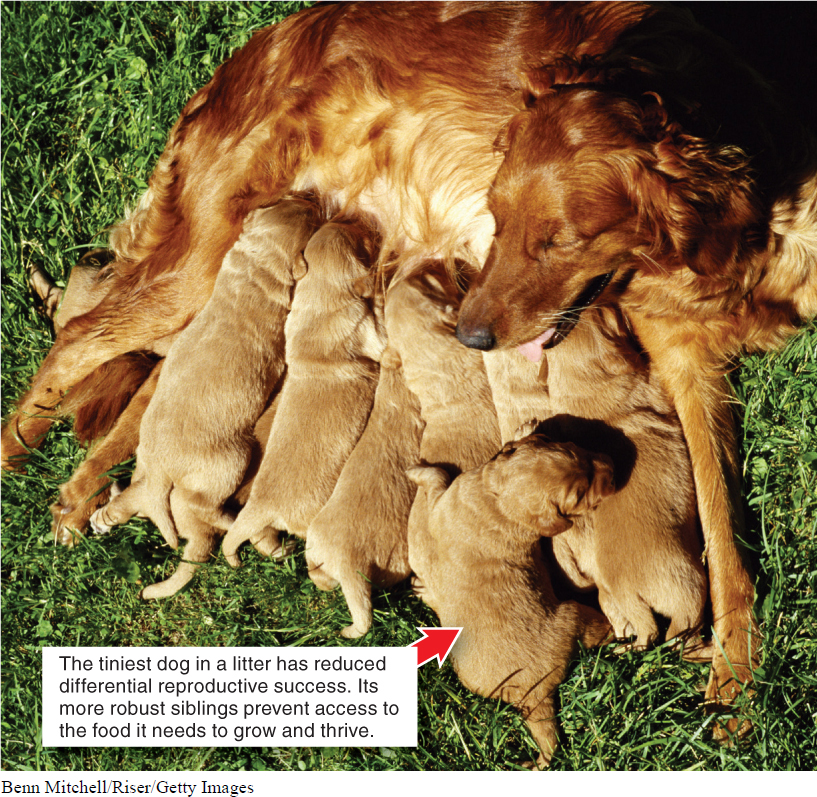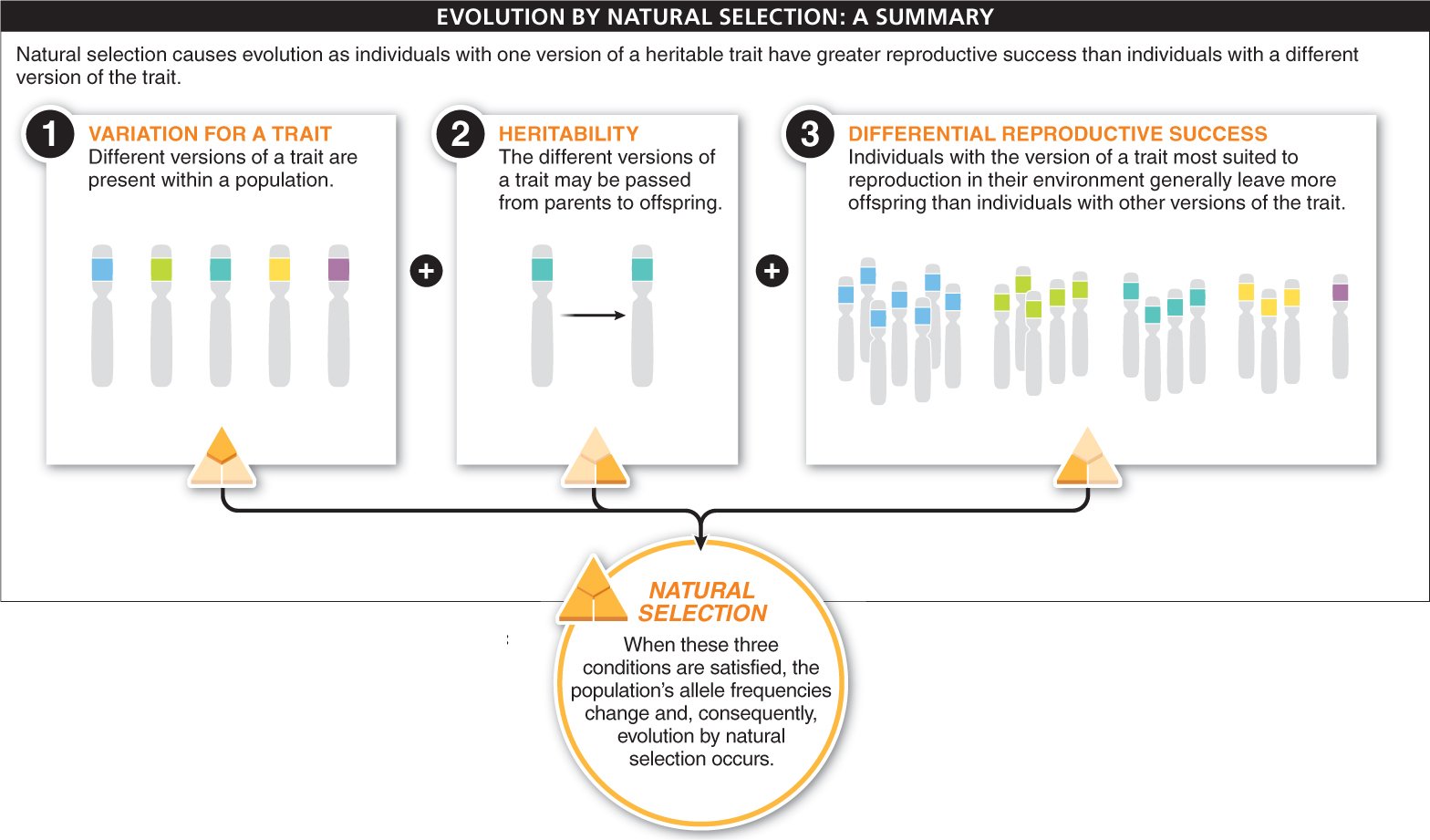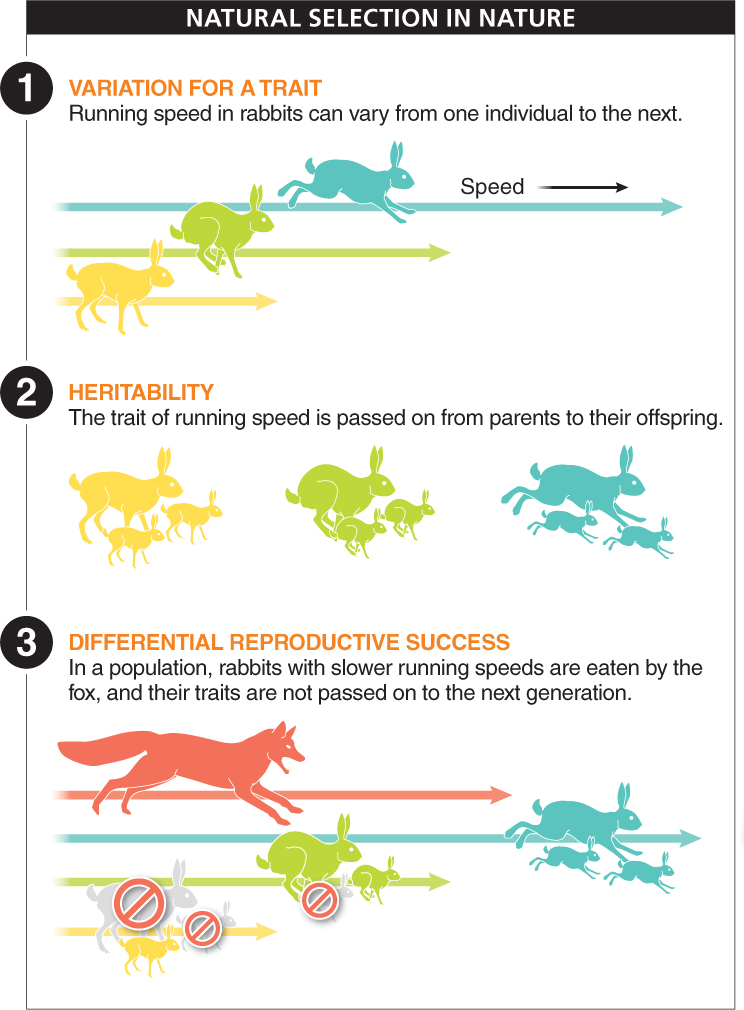The fourth mechanism of evolutionary change is natural selection. This is the mechanism that Darwin identified in The Origin of Species, in which he noted that three conditions are necessary for natural selection to occur:
- 1. There must be variation for the trait within a population.
- 2. That variation must be heritable (that is, capable of being passed from parents to offspring).
- 3. Individuals with one version of the trait must produce more offspring than those with a different version of the trait.
Let’s examine these conditions more closely.
Condition 1: Variation for a Trait Close your eyes and imagine a dog. What does the dog look like? If 50 people were asked this question, we would probably get 50 different dog descriptions (FIGURE 8-16). Some are big, some are small. Some have short hair, some long. They vary in just about every way you can imagine. Likewise, if 50 people were to imagine a human face, a similarly broad range of images would pop into their heads. Variation is all around us. Beyond making the world an interesting place to live in, variation serves another purpose: it is the raw material on which evolution works.

Variation is not limited to physical features such as fur color or face shape. Organisms vary in physiological and biochemical ways, too. Some people can quickly and efficiently metabolize alcohol, for example. Others find themselves violently ill soon after sipping a glass of wine. Similarly, we vary in our susceptibility to poison ivy or diseases such as malaria. Behavioral variation—
Condition 2: Heritability The second condition that Darwin identified as necessary for natural selection was a no more complex discovery than the first: for natural selection to happen, offspring must inherit the trait from their parents. Although inheritance was poorly understood in Darwin’s time, it was not hard to see that, for many traits, offspring look more like their parents than like some other, random individual in the population (FIGURE 8-17). Animal breeders had long known that the fastest horses generally give birth to the fastest horses. Farmers, too, understood that the plants with the highest productivity generally produce seeds from which highly productive plants grow. And everyone knew that children resemble their parents. It was enough to know that this similarity between offspring and parents exists—

333
Condition 3: Differential Reproductive Success It would be nice to say that Darwin made a stunning and insightful discovery for the third of the three conditions necessary for natural selection, but he didn’t. Rather, he derived the third condition for natural selection from three fairly simple observations. First, more organisms are born than can survive. Second, organisms are continually struggling for existence. Lastly, some organisms are more likely than others to survive and reproduce. In a world of limited resources, finding food or shelter is a zero-
This three-

334
That’s it. Natural selection—
- 1. Variation for a trait
- 2. Heritability of that trait
- 3. Differential reproductive success based on that trait

When these three conditions are satisfied, evolution by natural selection is occurring. It’s nothing more and nothing less. Over time, the traits that lead some organisms to have greater reproductive success than others will increase in frequency in a population, while traits that reduce reproductive success will become less and less common.
In most agricultural pests treated with pesticides, a resistance to the pesticides evolves. How does this happen?
When it comes to some traits, the reason they specifically confer greater reproductive success is that they make the individual more attractive to the opposite sex. Such traits—
Another way of looking at natural selection is to focus not on the winners (the individuals who are producing more offspring) but on the losers. Natural selection can be viewed as the elimination of some heritable traits from a population. If you carry a trait that makes you a slower-

335
One of Darwin’s contemporaries, Thomas Huxley, supposedly cursed himself when he first read The Origin of Species, saying that he couldn’t believe he didn’t figure it out on his own. Each of the three basic conditions is indeed simple and obvious. The brilliant deduction, though, was to put the three together and appreciate the consequences.
TAKE-HOME MESSAGE 8.9
Natural selection is a mechanism of evolution that occurs when there is heritable variation for a trait, and individuals with one version of the trait have greater reproductive success than do individuals with a different version of the trait. Natural selection can also be thought of as the elimination of alleles that reduce the reproductive rate of individuals carrying those alleles, relative to the reproductive rate of individuals who do not.
What conditions must be met for evolution by natural selection to occur? Provide an example.
First, there must be variation for the trait within a population. Second, that variation must be heritable. Third, individuals with one version of the trait must produce more offspring than those with a different version of the trait. Consider an example with rabbits. Running speed is a trait that is passed from parents to their offspring. Rabbits with slower running speeds get captured and eaten by predators before they can pass on this trait to the next generation. Therefore, the next generation will contain fewer slow rabbits. Over time, the population is changed by natural selection.